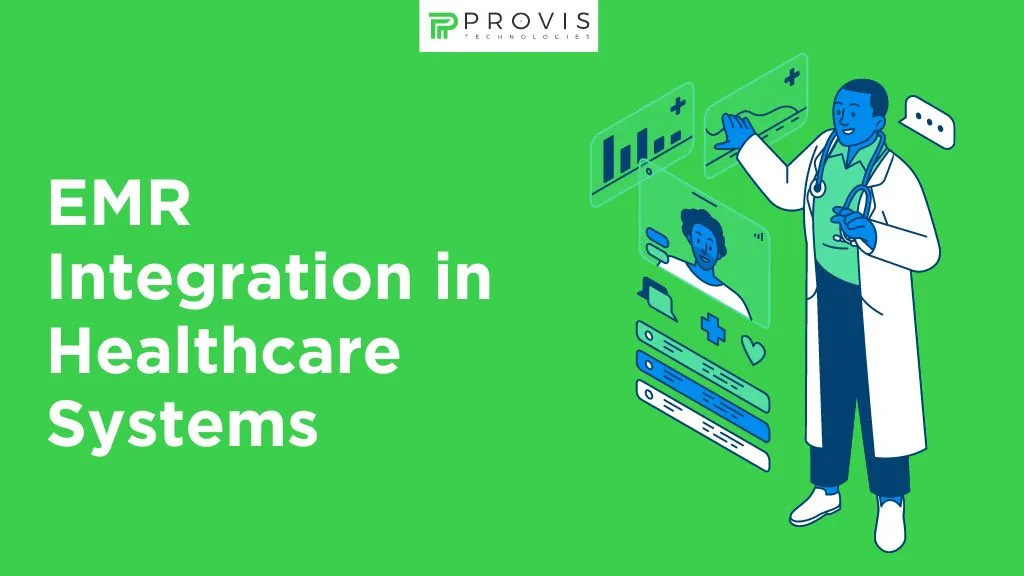In what ways can the healthcare systems advance further without compromising the safety of the patients? Handling medical records by hand takes a lot of time and brings several odds. Integrating EMR brings the solutions. It aids in the easy management of patient files.
Doctors and nurses can quickly access information, fix mistakes right away, and save time while treating patients. This improves care for patients and helps follow health rules.
EMR integration saves time and paperwork every day and helps advance many common issues in medicine. Find out how medical professionals can change how data is manipulated for better and faster patient care.
Don’t Miss:- A Complete Guide to Pharmacy Management Software Development
Key Benefits of EMR Integration in Healthcare
1. Improved Patient Care
An EMR system enables physicians to perform duties quickly. Since all health data is provided in electronic formats, filing cabinets become unnecessary. Diseases are diagnosed in shorter periods and treated more effectively, achieving quality patient care.
2. Fewer Medical Errors
Writing patients’ records on paper has made mistakes commonplace. However, EMR has helped eliminate that by incorporating ancillary devices into the system that facilitate data storage. A doctor cannot miss previous treatment activities and prescriptions, and inappropriate medication or therapy will not occur. Thus, this enhances patients’ safety and reduces medication errors.
3. Better Coordination
The exchange of patient information requires no effort from EMR providers. This makes it easier to work across different units and specialists as key players involved in the patient are all up to date, eliminating unnecessary delays as concern treatment.
4. Time and Cost Savings
Instead, less time and resources will be consumed in deciding how to use filled forms and when to do the data entry. Time and money that would have been incurred to create office space and perform related administrative duties is significantly reduced. This means that more attention can be directed to the delivery of patient services and that overall costs in the operations of hospitals and clinics will be lower.
5. Enhanced Data Security
Data encryption and access control optimization provide a better solution to the 3rd party threats to electronic records. Electronic records can be locked up or eliminated, unlike paper records.
Must Know:- Software Development Vs Application Development: Key Differences and Similarities
Essential Features of an EMR System
1. Patient Data Management
An EMR is the culmination of four main patient information systems: insurance information, history of allergies, history of surgical management, and notes from physicians, including diagnoses and other findings.
This allows for quick and accurate record-keeping since all the pertinent information needed by doctors and caregivers is available and up to date, and practitioners can make decisions based on accurate records.
2. Electronic Prescribing (e-Prescriptions)
Using e-prescribing tools, doctors can send prescriptions to drug stores. This eliminates prescription mistakes, reduces problems with unreadable writing, and ensures that the time to get medicine is done faster, increasing efficiency in the healthcare system.
3. Appointment Scheduling
EMRs have built-in referral service appointment planners to facilitate the scheduling of appointments. Patients are able to request, change, or cancel appointments easily, while detailed information concerning upcoming consultations is also available for physicians, which eliminates scheduling turnovers to have a proper allocation of time.
4. Clinical Decision Support
The EMR also has support tools for doctors to make clinical decisions, such as treatment protocols, reminders for preventive interventions, and alerts on prescription/therapeutic drug interactions. This helps physicians arrive at clinically safer and more accurate choices since the physician’s decision is not purely subjective but objective.
5. Interoperability
It has already been mentioned that the EMR system must also integrate with other healthcare systems to effectively share data among various healthcare providers. This helps that whenever new patients register in a hospital or any medical facility, the details are immediately available at every facility, including hospitals, clinics, and pharmacies.
6. Customizable Templates
EMRs contain default templates for notes, charts, and reports, which help reduce the time taken to record the patient’s information. Such templates can be changed to suit different specialties. These will assist in ensuring that the necessary information is captured in a timely and standardized manner throughout different clinical practices.
7. Billing and Coding Support
Third, billing and coding are embedded in most EMR systems, thus billing all the rendered services. This feature helps healthcare administrations avoid inconveniences like billing errors and enhance the efficiency of administrative tasks while staying compliant with healthcare standards and reimbursements.
8. Secure Messaging
Apart from that, EMRs also provide internal communication through encrypted messaging between healthcare professionals and patients. This means that certain protected health information can be sent out without risk, making communicating and complying without risk to data easier.
9. Data Analytics and Reporting
Additionally, EMR systems make provision for report generation and perform analytics of the data collected on patients to aid in understanding essential information like treatment patterns and their turnaround rates. The aim is to enable healthcare providers to keep track of patterns.
Related Blog:- Healthcare Mobile App Design: Key Guidelines
The Process of Integrating EMR into Healthcare Systems
1. Assessing Healthcare Needs
As a first step, healthcare facilities shall analyze fundamental things like patient load, current workflows, and data processes before implementing any EMR system. This assists in making a wise EMR selection for the facility.
2. Choosing the Right EMR System
Choosing the right EMR is of utmost importance for the services rendered by the healthcare facility. It should be a satisfactory necessity, compatible, and have enhanced features such as data security, scalability, and highways for staff adoption, which are easy to use.
3. System Customization
EMR solutions must be adjusted to conform with the specifics of the health care institution. Personalization entails producing forms and templates, instituting the roles of the users, and regulating the processes so that the systems can be easily utilized in routine activities.
4. Data Migration
Data strategies on paper or old systems must be transferred to the new EMR system. This activity is about obtaining ‘clean’ data, contacting old patients, re-entering their history discreetly, and relocating all medical records safely to the system.
5. Staff Training and Support
Experience and the type of orientation given to personnel are critical to enhancing the proper integration of EMR in health institutions. To do this, the health care providers and administrative workers must be taught the system’s usage, data organization, and management, as well as what can be done to fix frequent problems.
Also Read:- How to Choose a Mobile App Development Framework: A Beginner’s Guide
Cost Breakdown of EMR Integration
- Deployment Model: There is a steady cost for costs depending on the mode of delivery. On-premise systems require a high first-month cost. However, for cloud-based solutions, monthly subscription plans are made available, which can be cheaper in the end.
- Software pricing: It can cover upgrades, relevant software applications, and interface modules. Expenses depend on the type of system, whether it is a cloud system or an on-premise one.
- Hardware: Essential equipment comprises laptops, tablet PCs, servers, and peripherals, including scanners, printers, etc. Such expenses can accumulate quite a bit.
- Training: The cost of settling employees into the new system can reach a maximum of $20,000, depending on the number of trained employees.
- Staffing: For medium and large businesses, additional staffing costs, such as changing the total cost, can be appropriate.
- System Installation and Configuration: The cost of installing the system and configuration varies between $1,000 and $3,000, depending on the arrangement diagram.
- Hidden or Unexpected Costs: Consider unexpected costs, such as specially designed software, joining the new program with the current one, and hiring new IT experts for day-to-day requirements.
Conclusion
Introducing EMR systems has many advantages in health care, such as enhancing care and lessening errors. However, the introduction of these systems also faces obstacles such as financial burden, lack of sufficient data migration means, and human asset preparedness.
Knowing the main characteristics of EMR systems can help healthcare practitioners select the most appropriate choice. Moreover, estimating the costs of deployment, software, hardware, and maintenance must be done effectively when budgets are drawn.
This way, medical establishments can improve their processes, normalize systems and processes, and render services to patients without infringing laws or compromising data security.
Written By
Author's Picks
- How Mobile First E-commerce Design Can Boost Conversions in 2025
- 26/04/2025
- The Impact of 5G on Mobile App Development: What Developers Need to Know
- 17/09/2024
- Abandoned Cart Email Strategy: 11 Best Tactics to Boost Sales by 30%
- 23/04/2025
Categories
- AI for Startups
- AI in Web Development
- AI Integration
- AI Platforms
- AI Prompt
- AI Tools
- AI Trading Software
- Android App
- Android vs iOS Development
- Angular
- API
- API Development
- App
- app development
- App Idea
- App User Feedback
- Application
- Artificial Intelligence
- Audit Services
- Automotive Industry
- Awards and Recognition
- Business Consulting
- Business Website
- Chatbots
- CRM
- CRM for Financial Advisors
- Custom CRM
- Custom SaaS
- Custom Website
- Customer Service
- dashboard design
- Developing a Mobile App
- Digital Business
- E-commerce
- EMR Integration
- Finance
- Financial Advisors
- Financial Advisors
- GIT
- Health Insurance
- iOS App
- iOS App Development
- IoT Mobile App Development
- IoT Platforms
- IT Audit Services
- IT Consulting
- IT Strategies
- Java Development
- Laravel
- Lean Canvas
- Learning Management System
- Logistics Apps
- Mobile App Development
- MVP
- Native App
- News Aggregator Site
- OTT
- Outsourcing IT
- Payment Gateway
- predictive analysis
- Product Launch Strategy
- Progressive Web App (PWA)
- Prototype
- Recommender Systems
- Ruby
- SaaS
- SaaS Application
- SaaS Business
- SaaS Company
- SaaS Development
- SaaS Product
- SaaS Project
- Sales Funnel
- SEO
- Shopping Cart
- Software Development
- SSL and TLS
- Startup Checklist
- Technology
- Tetradic Color Scheme
- UI/UX Design Company
- Unit Testing
- User Flow
- User Testing
- Web Development
- Web Performance Optimization
- website Maintenance Services
- Website Migration Service
- Website Speed Optimization
- WooCommerce
- WordPress





